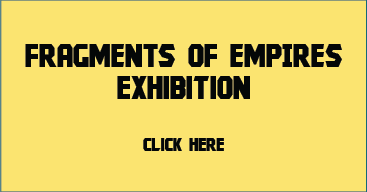 |
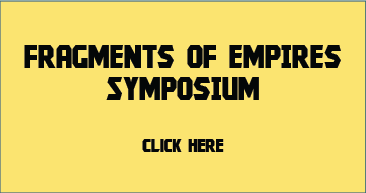 |
 |
AFTER THE WALL
A Sound Sculpture by Artist Lutz Becker (1999 / 2014)
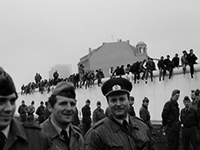 |
AFTER THE WALL – Potsdamer Platz
|
|||
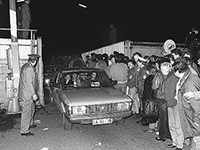 |
AFTER THE WALL – Invalidenstrasse
|
|||
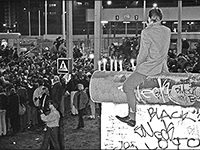 |
AFTER THE WALL – Checkpoint Charlie
|
|||
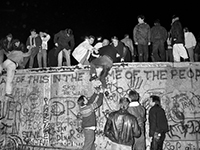 |
AFTER THE WALL – Brandanburger Tor
|
|||
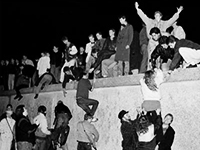 |
AFTER THE WALL – Night
|
For the 25th Anniversary of the Fall of the Berlin Wall
And So That Everyone Can Join In On The Day:
A FREE DOWNLOAD TO CELEBRATE THE POWER OF THE PEOPLE!
DOWNLOAD IT AND PLAY IT LOUDLY ON 9 NOV 2014!
WE WANT EVERY CITY WORLDWIDE TO RING WITH THE UNCOMPROMISING SOUNDS OF FREEDOM.
The Berlin Wall was first breached on 9th November 1989, as the result of popular mass meetings and demonstrations within the GDR. It was not demolished at a single stroke, but over days and weeks was slowly chipped away as people from East and West joined together to obliterate a hated symbol of oppression. This was the first in a chain of events that led to the end of the Soviet Union and the Iron Curtain. Europe was freer than it had ever been before! And the ramifications spread the world-over!
In 1989 the whole of Berlin rang and rocked to the liberating sound of hammers and pickaxes as the Wall was demolished. It was intended to build a better world without any walls.
Artist and film-maker Lutz Becker made a montage of these percussive sounds as the opening work in After the Wall, a large exhibition of art from the post-communist countries of Europe, that opened in 1999 on the 10th anniversary of this world-changing event. Now for the 25th anniversary, to coincide with the opening of Fragments of Empires at MOMENTUM Berlin, we encourage you to download any of the 5 tracks of this sound sculpture, resonating through time into the present and future.
Remind politicians today that it was the power of the people that brought down the Wall in 1989 and that ideals of freedom have still to be protected!
Wherever you are in the world, download the Wall and play it loudly on Nov 9!!!
For FRAGMENTS OF EMPIRES We Are Proud To Announce
The Limited Edition Record Release With The Vinyl Factory
OF
AFTER THE WALL
A Sound Sculpture by Artist Lutz Becker (1999 / 2014)
AFTER THE WALL at the Fragments of Empires Exhibition
For Fragments of Empires, Lutz Becker re-visits a sound installation commissioned for the exhibition After the Wall held at the Moderna Museet Stockholm in 1999, also curated by David Elliott. Its five constituent sound montages are based on original recordings made at the fall of the Berlin Wall. After its installation in Stockholm it travelled subsequently to Budapest and Berlin. MOMENTUM presents the sound sculpture After The Wall in the context of the 25th anniversary of the fall of the Berlin Wall. The fall of the Berlin Wall 25 years ago, in November 1989, symbolised the end of the separation of the City of Berlin, as well as that of Germany into an Eastern and a Western state. It marked, for everybody to see, the final collapse of Communism. It was a moment in history that promised to the people of Germany and other Europeans a new beginning. The significance of the Berlin Wall extended far beyond the city, beyond the borders of Germany. It epitomised the Cold War confrontation between the Warsaw Pact and the NATO alliance. The Wall separated the spheres of interest between Communism and Capitalism. On 13. August 1961 the government of East Germany, the GDR, began to seal off East Berlin from West Berlin by means of barbed wire and anti-tank obstacles. The underground and railway services of Greater Berlin were severed and West Berlin was turned into an island within GDR territory. A solid wall gradually replaced the provisional fence. It was made up of concrete segments of a height of 12 feet and was 165 miles long.
A trench ran parallel to it to prevent vehicles from breaking through. There was a patrol corridor behind it, watch towers, bunkers and electric fences. It appeared to the population of Germany that the split of their country and of Berlin would last forever. In 1989, as a reaction to Gorbachov’s reforms in the Soviet Union and massive unrest in their country, the government of the GDR decreed the opening of the Wall on 9. November 1989. In the following days and months demolition workers began with tearing it down. On 1. July 1990 the GDR gave up her statehood and merged with West Germany. For the Germans the demolition of the wall was an act of liberation. It gave hope for a future in which unhindered communication and freedom of movement would be everybody’s natural right. Within days of the ‘opening’ of the wall its terrifying symbolism lost its power. Millions of people came to Berlin to look at the now defunct wall and to take a piece of it with them to remember this moment of history. Hundreds of people attacked the graffiti covered surfaces of the Wall, eroding it bit by bit. The so called ‘Mauerspechte’, wall-peckers as opposed to woodpeckers, worked on the Wall day and night; their hammering, knocking and breaking sounds travelled along the many miles of Wall. The high density concrete of the structure worked like a gigantic resonating body; its acoustic properties created eerie echoes driven by the random percussion of the hammering.



